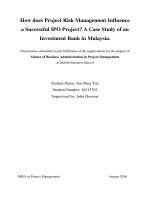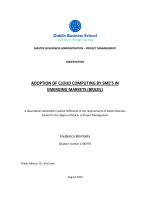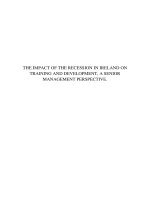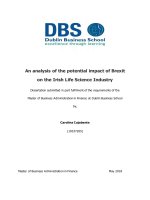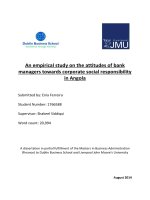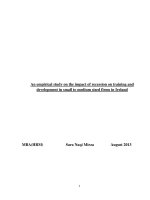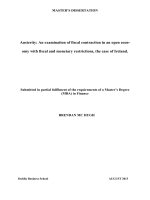Master Thesis in Economics: Adoption of cloud computing by SME''s in emerging markets (Brazil)
Bạn đang xem bản rút gọn của tài liệu. Xem và tải ngay bản đầy đủ của tài liệu tại đây (8.01 MB, 136 trang )
MASTER IN BUSINESS ADMINISTRATION – PROJECT MANAGEMENT
DISSERTATION
ADOPTION OF CLOUD COMPUTING BY SME’S IN
EMERGING MARKETS (BRAZIL)
A dissertation submitted in partial fulfillment of the requirements of Dublin Business
School for the degree of M.B.A. in Project Management
Frederico Brimbela
(Student number 1706797)
Thesis Advisor: Dr. Brid Lane
August 2013
Declaration:
I Frederico Brimbela declare that all the work in this dissertation is entirely my own unless
the words have been placed in inverted commas and referenced with the original source.
Furthermore, texts cited are referenced as such, and placed in the reference section. A full
reference section is included within this thesis.
No part of this work has been previously submitted for assessment, in any form, either at
Dublin Business School or any other institution.
__________________________
16th of August 2013
To my family in special to my wife:
Your willing sacrifice, boundless support, and unending love that made this journey possible.
For that, I am forever grateful!
ABSTRACT
Cloud Computing is an exciting topic, which is providing a paradigm shift from
computation as a product to computation as a service. It is a phenomenon where various
types of IT capabilities are centralized into data centers to ensure that such resources are
available wherever and whenever they are needed and instead of purchasing costly
hardware and software which requires installation, maintenance and configuration, Cloud
Computing provides the usage of Cloud application and infrastructures based on pay per
usage scheme.
To better understand the organizational application of Cloud Computing this research
aims both to investigate economic payoffs from Cloud Computing investment and
explores Cloud Computing adoption within the firm. More specifically, the influential
factors that impact adoption of Cloud-based technologies by Small and Medium
Enterprises in Emerging Markets, in particular Brazil. Opportunities and challenges in the
area of Cloud Computing adoption and its impact in the growing economies are also
discussed.
Brazil is South America's most influential country and an economic giant. Brazilian SMEs
and Entrepreneurs do not have mass computation to run their applications and to meet
the changing requirements. Thus, Cloud Computing is growing by offering advanced IT
applications to meet the rapid changing environment.
This dissertation is based on the study and evaluation of SMEs using Salesforce.com
services and its adoption framework in Brazil. For this study 170 Salesforce.com users
from different SMEs organizations, were surveyed, a number of quantitative
measurements were performed to provide a better understanding of some of the
adoption aspects. The main conclusion from this study shows for a better adoption
companies should use these solutions as part of a strategic effort for the organization. The
proposed study can make contributions for IS adoption literature and emphasis aspects
for a successful adoption of Cloud Computing solutions.
Key words: Adoption; Cloud Computing; Emergent Markets; Brazil; Salesforce.com;
JEL Classification System: M15- IT Management; M10-General; M31-Marketing;
Word Count: 18.492 Dissertation + 1.609 Self Reflection
TABLE OF CONTENTS
1.
Introduction..................................................................................................................... 1
1.1.
2.
1.1.1.
Industry Context .......................................................................................................... 2
1.1.2.
Emerging Markets Context (focus Brazil) .................................................................... 4
1.2.
Purpose .................................................................................................................... 6
1.3.
Target & Contribution .............................................................................................. 7
1.4.
Motivation for this Research ................................................................................... 8
1.5.
Research Question ................................................................................................... 9
1.6.
Brief Outline of dissertation .................................................................................. 10
Literature Review .......................................................................................................... 12
2.1.
Cloud Computing.................................................................................................... 12
2.1.1.
Characteristics and Technology ................................................................................ 13
2.1.2.
Cloud Computing Service Models.............................................................................. 15
2.1.3.
Deployment models of Cloud Computing ................................................................. 16
2.1.4.
Cloud Computing Advantage & Disadvantages ......................................................... 18
2.1.5.
Challenges of Cloud Computing ................................................................................ 19
2.1.6.
Impact of Cloud Computing in Business .................................................................... 20
2.2.
Small and Medium Enterprises .............................................................................. 22
2.2.1.
Characteristics of SMEs ............................................................................................. 23
2.2.2.
Characteristics of SMEs in Emerging Markets ........................................................... 24
2.3.
Adoption ................................................................................................................ 25
2.3.1.
Technology Adoption ................................................................................................ 25
2.3.2.
SMEs Adoption of Technology .................................................................................. 26
2.3.3.
Factors to be Considered in Cloud Computing Adoption by SME ............................. 29
2.3.1.
Cloud Computing for SMEs ........................................................................................ 30
2.4.
3.
Context ..................................................................................................................... 2
Emerging Markets .................................................................................................. 31
2.4.1.
Why Emergent Markets for this study ...................................................................... 31
2.4.2.
Brazil Cloud Computing overview ............................................................................. 32
Research Methodology ................................................................................................. 35
4.
3.1.
Research Structure................................................................................................. 35
3.2.
Sample.................................................................................................................... 38
3.3.
Ethics ...................................................................................................................... 39
3.4.
Limitations ............................................................................................................. 39
Data Analysis and Findings ............................................................................................ 41
4.1.
General Sample Demographics Characteristics ..................................................... 41
4.2.
Hypotesis Analysis.................................................................................................. 44
4.2.1.
Hypothesis 1 Analysis – Cloud Computing and its Technology ................................. 44
4.2.2.
Hypothesis 2 Analysis – Cloud Computing in the Organization................................. 54
4.2.3.
Hypothesis 3 Analysis – Cloud Computing and the Environment ............................. 58
4.3.
The findings ............................................................................................................ 60
4.3.1.
5.
6.
Fulfillment of purpose ............................................................................................... 60
Conclusions and Recommendations ............................................................................. 61
5.1.
Objectives achieved ............................................................................................... 61
5.2.
Validation of the laid hypothesis ........................................................................... 64
5.2.1.
Validation Hypothesis 1 – Cloud Computing and its Technology .............................. 64
5.2.2.
Validation Hypothesis 2 – Cloud Computing in the Organization ............................. 67
5.2.3.
Validation Hypothesis 3 – Cloud Computing and the Environment .......................... 68
5.3.
Summary - Contributions to the Body of Knowledge ............................................ 69
5.4.
Future Research ..................................................................................................... 71
Self Reflection................................................................................................................ 72
6.1.
Learning styles ....................................................................................................... 72
6.2.
Masters Experience................................................................................................ 74
6.3.
Influence of learning style on the research ........................................................... 74
6.4.
Development skills ................................................................................................. 75
6.5.
Going Forward ....................................................................................................... 76
7.
References ..................................................................................................................... 77
8.
Appendices .................................................................................................................... 82
8.1.
Email Invitation to particiapte in the survey ......................................................... 82
8.2.
Survey..................................................................................................................... 83
8.3.
Descriptive Survey Analysis ................................................................................... 92
8.4.
Hypothesis Testing ................................................................................................. 97
8.4.1.
Appendix H1 Testing – Cloud Computing and its Technology ................................... 97
8.4.2.
Appendix H2 Testing – Cloud Computing in the Organization ................................ 118
8.4.3.
Appendix H3 Testing – Cloud Computing and the Environment ............................. 125
LIST OF FIGURES
Figure 1 - Computing Cycle ..................................................................................................... 2
Figure 2 - Social Media Revolution ......................................................................................... 3
Figure 3 - Map of Emerging Markets ...................................................................................... 4
Figure 4 - Brazil Population Density ....................................................................................... 6
Figure 5 - Conceptual Model Framework for the Research Topic ....................................... 10
Figure 6 - Illustration of Cloud Computing Model ................................................................ 12
Figure 7 - Contributed technology fields to the advent of Cloud Computing ...................... 15
Figure 8 - Simple Cloud Computing Model - Basic Cloud Services ....................................... 16
Figure 9 - Conceptual Model Framework on Cloud Adoption.............................................. 26
Figure 10 - Company Segmentation by Size in Brazil ........................................................... 33
Figure 11 - Research Methodology Sequence Structure...................................................... 35
Figure 12 - Cloud Computing Adoption framework ............................................................. 62
Figure 13 - Systems commissioning process ........................................................................ 64
Figure 14 - Cloud Computing and its organizational changes .............................................. 68
Figure 15 - Kolb's Learning Styles ......................................................................................... 72
LIST OF CHARTS
Chart 1 - Cloud Computing Market Forecast .......................................................................... 1
Chart 2 - World Wide Cloud Computing Market Value in B$ ................................................. 4
Chart 3 - Brazilian GDP growth 2001-2012............................................................................. 5
Chart 4 - UE importance of SMEs in the different sectors ................................................... 22
Chart 5 - SME importance on the breakdown of EU-27 value added .................................. 23
Chart 6 - Top 20 non-OECD countries of nominal GDP in 2010 ........................................... 31
Chart 7 - Location/Brazilian State ......................................................................................... 41
Chart 8 - Job Role .................................................................................................................. 42
Chart 9 - Job Level................................................................................................................. 42
Chart 10 - Business Model .................................................................................................... 43
Chart 11 - Involvement with Salesforce.com........................................................................ 43
Chart 12 – Salesforce.com service rates ............................................................................... 45
Chart 13 – Salesforce.com Overall Experience ..................................................................... 47
Chart 14 - Choices to deploy the technology ....................................................................... 48
Chart 15 - Advantages of the Technology in the business ................................................... 49
Chart 16 - Estimated time to achieve Return of Investment ............................................... 49
Chart 17 - Recommended Salesforce.com ........................................................................... 51
Chart 18 - Salesforce.com service helped to achieve business goals ................................... 51
Chart 19 - Estimated Return of Investment with Salesforce.com ........................................ 52
Chart 20 - Estimated time it took to achieve the ROI with Salesforce.com ......................... 53
Chart 21 - Intention to continue to use Salesforce.com ...................................................... 54
Chart 22 - Salesforce.com plan for the next 12 months....................................................... 54
Chart 23 - Professionals in CRM and non CRM using and not using Salesforce.com ........... 55
Chart 24 - Recommend Salesforce.com to others ................................................................ 58
Chart 25 - Performance of Salesforce.com sales team......................................................... 58
LIST OF TABLES
Figure 1 - Computing Cycle ..................................................................................................... 2
Figure 2 - Social Media Revolution ......................................................................................... 3
Figure 3 - Map of Emerging Markets ...................................................................................... 4
Figure 4 - Brazil Population Density ....................................................................................... 6
Figure 5 - Conceptual Model Framework for the Research Topic ....................................... 10
Figure 6 - Illustration of Cloud Computing Model ................................................................ 12
Figure 7 - Contributed technology fields to the advent of Cloud Computing ...................... 15
Figure 8 - Simple Cloud Computing Model - Basic Cloud Services ....................................... 16
Figure 9 - Conceptual Model Framework on Cloud Adoption.............................................. 26
Figure 10 - Company Segmentation by Size in Brazil ........................................................... 33
Figure 11 - Research Methodology Sequence Structure...................................................... 35
Figure 12 - Cloud Computing Adoption framework ............................................................. 62
Figure 13 - Systems commissioning process ........................................................................ 64
Figure 14 - Cloud Computing and its organizational changes .............................................. 68
Figure 15 - Kolb's Learning Styles ......................................................................................... 72
ACKNOWLEDGEMENTS
This dissertation is the culmination of a two year MBA journey that could not have been
accomplished without the support of many people. I am glad to have the opportunity to
acknowledge them here.
First and foremost, I would like to express my deepest gratitude to my advisor, Dr. Brid
Lane, who has been a constant source of encouragement, wisdom and optimism.
I would like to express my gratitude to Salesforce.com, for its financial sponsorship for
enrolling the MBA program.
I would like to thank my management team at Salesforce.com, during the entire course
they encouraged, motivated, and accompanied me throughout my research: Arsenio
Otero, VP Sales Development & Sales Strategy; Korstiaan Hardam, Senior Business
Development Director; Charlie Weijer, SMB Sales Manager Southern Europe and to
Sebastien Carre, Business Development Manager Southern Europe. From overseas, I
would like to highlight and express my gratitude to Wendy Close, Customer Research
Director, who helped me with the data collection and to Pedro Martins, VP SMB
Operations & Strategy for sharing his experience and for all the advices. Last but not least,
I would like to express my gratitude to Christophe Bichaut, Senior Manager Technical
Support, for all the support.
I also would like to thank all the lecturers who participated in the delivery of the Dublin
Business School MBA program.
Without naming anyone in particular, gratitude goes out to my MBA colleagues for two
years of highly beneficial shared values and experiences.
ADOPTION OF CLOUD COMPUTING BY SMEs IN EMERGING MARKETS (Brazil)
1. INTRODUCTION
Companies are deciding for Cloud solutions to reduce up-front costs and overall IT
spending, this way they are able to invest more in other initiatives such as Customer
Experience rather than Hardware or Software. That’s the real advantage of the Cloud, it
lets businesses rethink where and how they set up their IT budget, and let them to focus
more on what truly matters (Forbes, 2013).
The topic of my research is the adoption of Cloud Computing solutions by Small and
Medium size Enterprises (SMEs) in Emerging Markets (focus on Brazil). Cloud Computing
isn’t a trend anymore it has become an important tool for many organizations (Vaquero,
et al., 2009). It helps organizations to outsource their IT, instead from having it in-house.
A report from IDC suggests revenue of $26 billion from the Cloud Computing industry
during 2012 (IDC, 2009). Another avant-garde report from Gartner in 2012, anticipates
Cloud Computing as an influential technology with significant financial impact (Gatner,
2012). Their global forecast for Cloud services market’s revenue is to exceed $68.3 billion
in 2010 and reach $222.5 billion by 2015 (Gatner, 2012), Chart 1 bellow.
Chart 1 - Cloud Computing Market Forecast
Source: G artner, 2012
SMEs are known to be a critical element of the economy. According to the Observatory of
European SMEs, more than 90% of all European businesses consist of less than 10
employees (European Commission, 2005). SMEs are important to almost all economies, in
the world, but especially for Emergent countries that are more willing to grow and adapt
to new technologies (Ocampo, 2005). The adoption of Cloud Computing solutions from
_________________________________________________________________________
Dublin Business School | MBA Dissertation | Frederico Brimbela
1
ADOPTION OF CLOUD COMPUTING BY SMEs IN EMERGING MARKETS (Brazil)
SMEs’ is well known, but what is less well understood is how they are adopting these
solutions and what motivate them to continue using it.
Brazil at the moment is a trend country. Standard & Poor's, Moody's and Fitch, some of
the worlds most important rating agencies, awarded Brazil with investment grade in 2008.
Some of the reasons to focus this study in Brazil is because Brazil is also ranked the
world´s 6th largest economy and is expected to rank 5th in the next decade, the country
also plays a leading role in Latin American economy and politics, standing out with
increased attractiveness in the international scene, it is going to be the stage of the next
world cup in 2014 and Olympic games in 2016 (Forbes, 2012).
1.1.
CONTEXT
In this section it will be covered a briefly context about the Cloud Computing industry and
its evolution, the Emergent Markets in general and focus on Brazil context.
1.1.1. INDUSTRY CONTEXT
The Information Technologies industry is very dynamic. It's constantly changing, every
single decade a very strong change happens, as we can see in Figure 1 bellow.
Source: Salesforce.com , 2011
Figure 1 - Computing Cycle
_________________________________________________________________________
2
Dublin Business School | MBA Dissertation | Frederico Brimbela
ADOPTION OF CLOUD COMPUTING BY SMEs IN EMERGING MARKETS (Brazil)
From the Mainframe Computing era in 1960 brought to us with IBM, with Thomas Watson
Jr. 1970 to the Mini Computers era with Ken Olsen. Later the Digital Era Computing on the
80’s. The following decade, another change, into the Personal Computer era, with Bill
Gates leading these years.
In the 00’s we moved into a mobile era, led by Steve Jobs. Now, in the 10’s we're entering
into a new era, and this new era it's happening today, the one that is changing the way
business and communication are done. The model promises a shift from an organization
required to invest heavily for limited IT resources that are internally managed, to a model
where the organization can buy or rent resources that are managed by a Cloud provider,
and pay per use. Cloud Computing also promises scalability of resources and on-demand
availability of resources (Erdogmus, 2009).
Another interesting fact is the number of users grew 10 times more (Figure 2) with each
cycle (Howard, 2002).
Source: Salesforce.com , 2011
Figure 2 - Social Media Revolution
The beginning of Cloud Computing has sparked an interest in different organizations,
institutions and users to take advantage of web applications. This resulted in a new
economic model for the Information Technology (Vaquero, et al., 2009). Business
applications are moving to the Cloud. The shift from traditional software models to the
Internet has steadily gained momentum over the last 10 years. Looking ahead, the next
decade of Cloud Computing predictions say that will continue to grow, in the Chart 2
Gartner predicts that in 2013 the worldwide market value of Cloud Computing is 140B$.
_________________________________________________________________________
3
Dublin Business School | MBA Dissertation | Frederico Brimbela
ADOPTION OF CLOUD COMPUTING BY SMEs IN EMERGING MARKETS (Brazil)
Chart 2 - World Wide Cloud Computing Market Value in B$
Source: G artner, 2012
1.1.2. EMERGING MARKETS CONTEXT (FOCUS BRAZIL)
Emerging Markets are nations with social or business activity in the process of rapid
growth and industrialization, see Figure 3 in dark blue. The economies of China and India
are considered to be the largest. TThe
he seven largest emerging and developing economies
by either nominal or inflation-adjusted GDP are the BRIC countries (Brazil, Russia, India
and China), as well as MIKT (Mexico, Indonesia, South-Korea and Turkey) (The Economist,
2008).
Source: Mor gan St an ley, 2010
Figure 3 - Map of Emerging Markets
_________________________________________________________________________
4
Dublin Business School | MBA Dissertation | Frederico Brimbela
ADOPTION OF CLOUD COMPUTING BY SMEs IN EMERGING MARKETS (Brazil)
The ten big emerging markets are located in every part of the world. They will change the
face of global economics and politics, as they are a key swing factor in the future growth
of world trade, global financial stability, and the transition to free market economies in
Asia, Central Europe, and Latin America (Boguslavsky, 2011). These markets are also
crucial to nonproliferation, improvement of human rights, environmental cooperation,
and the avoidance of war in several critical areas (Subhash, 2006).
Brazil Context
Following three centuries under the rule of Portugal, Brazil became an independent nation
in 1822. By far the largest and most populous country in South America, Brazil has
overcome more than half a century of military intervention in the governance of the
country to pursue industrial and agricultural growth and development of the interior.
Brazil is also South America's most influential country, an economic giant and one of the
world's biggest democracies. It is one of the rising economic powers over the past few
years it has made major strides in its efforts to raise millions out of poverty. Brazil is
characterized by large and well-developed agricultural, mining, manufacturing, and service
sectors, Brazil's economy outweighs that of all other South American countries, and Brazil
is expanding its presence in world markets (I.M.F., 2012).
While the world´s average economic growth has remained either negative or close to zero
since the outbreak of the 2008 financial crisis, Brazil´s GDP reached 7.5% in 2010, the
highest score since 1986. Despite the 2008 global financial crisis, Brazil’s economy has
grown at an average of 3.5% per annum since 2001 and forecasts suggest that such levels
are likely to continue, Chart 3.
Chart 3 - Brazilian GDP growth 2001-2012
Source: IMF, 2012
_________________________________________________________________________
Dublin Business School | MBA Dissertation | Frederico Brimbela
5
ADOPTION OF CLOUD COMPUTING BY SMEs IN EMERGING MARKETS (Brazil)
As one of the so-called BRIC1, the country is rapidly becoming a global economic
powerhouse and now ranks as fifth in the world by GDP. Brazil is also arguably more
westernized than its BRIC competitors and is developing a marketing culture similar to the
USA and Western Europe (Subhash, 2006).
Brazil has become a global benchmark thanks to its sustainable economic growth, social
inclusion, expressive infrastructure investments and an industry which is under constant
modernization. The increase of purchasing power and the investment opportunities in
sectors like oil & gas, real estate, agribusiness as well as upcoming major sport events (the
2014 World Cup and the 2016 Olympic Games) help make the world's sixth largest
economy a safe investment destination (The Economist, 2008).
With a population of 200M, the majority of Brazilians lives within 300 kilometers of the
coast. In Sao Paulo are approximately 12M followed by Rio de Janeiro with 6.5M. While
the interior, in the Amazon Basin, is almost empty (Figure 4).
Source: index mu ndi, 2012
Figure 4 - Brazil Population Density
1.2.
PURPOSE
In recent years Cloud Computing has been one of the most discussed references in the
world of Information Technology. The adoption of Cloud Computing has become one
important subject for organizations, one question arises: what are the factors determining
the adoption of Cloud Computing?
1
BRIC is a grouping acronym that referred to the countries of Brazil, Russia, India and China, which are all
deemed to be at a similar stage of newly advanced economic development.
_________________________________________________________________________
6
Dublin Business School | MBA Dissertation | Frederico Brimbela
ADOPTION OF CLOUD COMPUTING BY SMEs IN EMERGING MARKETS (Brazil)
This dissertation attempts to provide a suitable roadmap, which will provide organizations
develop better strategies for Cloud Computing adoption projects. The purpose of this
research is give to the reader a better understanding of what Cloud Computing is
regarding to its adoption, implications as well as the process of adoption by SME in
Emerging Markets (Brazil). The intention is to fill a knowledge gap in the field of Cloud
Computing and provide the readers with knowledge that it will help to develop a better
strategy for adoption of Cloud by looking at the experience of existing Salesforce.com
customers and their decision to continue with Cloud Computing.
The aim is investigate the primary strategic issues in adopting Cloud Computing in an
organization, not the technical features or the theory behind it.
1.3.
TARGET & CONTRIBUTION
This work will give important insight into several areas of interest to different
stakeholders. First, it will add knowledge to the aspect of adoption in the Cloud Computing
field. Second, it builds detailed knowledge about the specific purpose to increase the
value of future SMEs in Emerging Markets investments in Cloud Computing. This research
is intended for researchers in the Information Systems area by developing a discussion
about the research topic. It looks forward to facilitate professionals, executives, project
managers to define the best roadmap for adoption of Cloud Computing by SME segment
in Emerging Markets context.
Academically SMEs are the base for student projects and future employment, it improves
the academic training of IT systems adoption. It also provides learning to students to help
them to develop IT adoption strategies/processes. Cloud Computing skills are different
from traditional systems development skills (Bridges to Technology Corp, 2005).
Knowledge about the specific needs of the regional companies will support the Dublin
Business School of ICT to focus its undergraduate training on relevant business challenges.
Finally, it could also support government initiatives aimed at stimulating the utilization of
IS/IT and recommendations for foreign investment in Emerging Markets.
_________________________________________________________________________
Dublin Business School | MBA Dissertation | Frederico Brimbela
7
ADOPTION OF CLOUD COMPUTING BY SMEs IN EMERGING MARKETS (Brazil)
1.4.
MOTIVATION FOR THIS RESEARCH
“Change is the law of life. And those who look only to the past or present are certain to
miss the future.” John F. Kennedy (1917-1963).
How aware are SMEs about the benefits of Cloud Computing? What are the main barriers
and concerns towards Cloud migration for SMEs? Actually working within this context, as a
Business Developer for Salesforce.com (a company leading in the Cloud industry) for EMEA
and doing a MBA in project management.
In this 21st century, many companies are witnessing great revival and revolution in their
business (Forbes, 2013). The world today is different from the world that we had decades
ago due to large innovation and invention in the field of Business and Technology (ENISA,
2009). Cloud Computing is one of the emerging areas in the field of information
technologies. It comes with many risks and has been billed as a hot-growth area based on
its potential benefits (Forbes, 2013). In the past few years, organizations have spent
millions of dollars adopting SFA2 systems, and this continues to grow (Abdulaziz, 2012).
Despite its significance, very little academic research has been devoted to understanding
the factors that can influence the effective adoption of SFA systems. Academic research
on the adoption of Cloud Computing and in particular the building of customer trust is
reduced. Few works have been done on the models of adoption strategies for Cloud
Computing. Security is the main topic (Mather, et al., 2009). Industry publication points to
the financial benefits of adopting Cloud Computing and the costs of migrating to Cloud
Computing (ENISA, 2009). There is few published work on considerations of adopting
Cloud Computing, as well as, the organizational impact that a Cloud Computing solution
causes. Business Practices have changed and technologies have transformed the way
organizations share and communicate information.
Understand what are the major adoption factors for SMEs before and after they adopted
Cloud services and what are the main expectations of SMEs from these solutions? These
are reasons that motivate the researcher to develop this study.
This dissertation aims to find a path, which will provide an understanding of factors that
contribute for a Cloud Computing adoption to follow and pass by organizational issues.
2
Sales Force Automation is a information systems used in CRM Marketing and Management that help
automate some sales and sales force management functions
_________________________________________________________________________
Dublin Business School | MBA Dissertation | Frederico Brimbela
8
ADOPTION OF CLOUD COMPUTING BY SMEs IN EMERGING MARKETS (Brazil)
1.5.
RESEARCH QUESTION
Many studies have been done to explain conceptually Cloud Computing, but few have
looked at how it is being used. Not only they are few, but they focus on just two general
areas: the effects at the financial level, and the technical considerations involved. None to
date have looked at its usage and its adoption on SME and in Emerging Markets. This
research proposes to fill these gaps, by focusing on the behavioral characteristics of Cloud
Computing adoption such as at organization level and the technology impact in the
organization.
This research will deal with the reasons which affect the adoption of Cloud Computing.
The purpose of this thesis is to find the factors and indicate their importance in relation to
their intention of using it. What are these main factors and how important are they.
What are the influences on adoption and repurchase intention by Salesforce.com
customers in Brazil?
The focus will be on the theory of adopting Cloud Computing and what makes
organizations adopted it. Focus only on Salesforce.com active customers, only from SME
segment in Brazil. The objectives of this study are:
•
•
•
Identify the key drivers before and after the purchase that drives a better
adoption. Understand the causes that drive to a potential repurchase intention;
Identify if it’s possible for client and vendor collaborate for successful Cloud
adoption project;
Understand what are the reasons by which SMEs adopt Cloud Computing into their
business;
This study intends to research the correlation from the actual experience and the
(re)purchase intention behavior. Below are the alternative hypotheses, Figure 5:
•
H1: Cloud Computing technology characteristics are associated with its
organizational adoption:
o H1a: Cloud Computing complexity is negatively associated with its
adoption;
o H1b: Relative advantage of Cloud Computing is positively associated with its
adoption;
o H1c: Demonstrable result of Cloud Computing is positively associated with
its adoption;
_________________________________________________________________________
Dublin Business School | MBA Dissertation | Frederico Brimbela
9
ADOPTION OF CLOUD COMPUTING BY SMEs IN EMERGING MARKETS (Brazil)
•
•
H2: Cloud Computing perceived results is positively associated with its
organizational adoption of Cloud Computing;
H3: Increased expectation for growing of Cloud Computing increases the expected
value of potential returns, thereby increasing the possibility of adopting these
solutions.
Source: Freder ico Brim bela, 2 013
Figure 5 - Conceptual Model Framework for the Research Topic
1.6.
BRIEF OUTLINE OF DISSERTATION
This dissertation is organized into 5 chapters.
Chapter-1 Introduction
In this chapter, current chapter is presented an introduction and background of
the industry and an overview of Emergent Markets, reasons of choosing this topic,
objectives, motivation, research problem and an outline of every chapter.
Chapter-2 Literature Review
In this chapter, concepts and issues of Cloud Computing, SMEs, Adoption and
Emergent Markets are discussed with different writers’ views. Factors responsible
for adoption of technology by SMEs are also discussed.
_________________________________________________________________________
10
Dublin Business School | MBA Dissertation | Frederico Brimbela
ADOPTION OF CLOUD COMPUTING BY SMEs IN EMERGING MARKETS (Brazil)
Chapter-3 Research Methodology
In this chapter is presented the method which is used to do data research and to
answer to the research question. Also reasons for choosing this method are
discussed.
Chapter-4 Data Analysis and Findings
Superficial and deeper analyses were done, in this chapter the survey results are
presented and analyzed. Data is interpreted and gathered in the light of the
literature review presented in chapter 2
Chapter-5 Conclusions and Recommendations
In this chapter, the conclusions of whole dissertation are presented.
Recommendations are also presented for implementation of the research findings
along with reflections of the learning experience.
_________________________________________________________________________
Dublin Business School | MBA Dissertation | Frederico Brimbela
11
ADOPTION OF CLOUD COMPUTING BY SMEs IN EMERGING MARKETS (Brazil)
2. Literature Review
In this section definitions will be stated on the term Cloud Computing and its different
characteristics are exposed, deployments and services models. Definitions of Adoption
and IT Adoption will be evaluated and connected to our research. To finish this chapter
the Emergent Markets concept with focus on Brazil market is presented. The information
in this section will be a foundation for data collection and later analysis.
2.1.
Cloud Computing
This section will provide an introductory background to Cloud Computing. This includes a
formal definition and a description of the main characteristics. It also introduces the three
types the services available from Cloud technologies namely IaaS, SaaS and PaaS. To finish,
will explains three types of Cloud deployment models used today. For the big picture of
this chapter see Figure 6 (Mell & Grance, 2009).
Source: N IST, 2012
Figure 6 - Illustration of Cloud Computing Model
The consulting company Gartner suggests a definition as follows “A style of Computing
where scalable and elastic IT-related capabilities are provided as-a-service using Internet
technologies to multiple external customers” (Plummer, et al., 2009)
The term Cloud Computing is one of the hottest in IT industry today. The concept of Cloud
Computing was born in the 1960s from the ideas of pioneers like Joseph Licklider (19151990) who pictures computation in the form of a global network and John McCarthy
_________________________________________________________________________
Dublin Business School | MBA Dissertation | Frederico Brimbela
12
ADOPTION OF CLOUD COMPUTING BY SMEs IN EMERGING MARKETS (Brazil)
(1927-2011) draft computation as a public utility (MIT Technology Review, 2011). Some of
the first uses included the processing of financial transactions and census data. Today,
Cloud Computing is a reality and it is a fast growing business.
Cloud Computing is the concept whereby Computing is seen as a service, is delivered to
the customers over the Internet, from large-scale data centers, or Clouds. Cloud
Computing has been defined as the new state of the art technique that is capable of
providing a flexible IT infrastructure, where users don’t need to own the infrastructure
supporting these services. Cloud Computing refers to both the applications delivered over
the Internet and the hardware and systems software in the datacenters that provide those
services, (Maximilien, et al., 2009). From a technical perspective, Cloud Computing mainly
focuses on service-oriented architecture and virtualization of both hardware and software
(Kaufman, 2009). This integrates features supporting high scalability and multi-tenancy.
2.1.1. CHARACTERISTICS AND TECHNOLOGY
There are salient characteristics of Cloud Computing that distinguishes it from other
Computing paradigms. Based on the definitions provided by the National Institute of
Standards and Terminology (NIST) the main characteristics are outlined in the next
paragraph:
•
•
•
Broad network access to Cloud resources is over the network using standard
mechanisms provided through thin or thick clients in a heterogeneous manner. A
standardized interface lets the customer more easily link Cloud services together.
Elasticity and scalability allows for rapid capability provisioning. The Cloud is
elastic, meaning that resource allocation can get bigger or smaller depending on
demand. Elasticity also enables scalability that means the application can scale
when adding users and when application requirements change. To the consumer,
the capabilities available for provisioning often appear to be unlimited and can be
purchased in any quantity at any time (Buyya, et al., 2011).
Measured service, the usage can be measured, controlled, and reported providing
transparency for both the provider and consumer of the utilized service. Cloud
systems automatically control and optimize resource use by leveraging a metering
capability at some level of abstraction appropriate to the type of service This
implies that just like air time, electricity or municipality water IT services are
charged per usage metrics, the concept: pay per use (Jensen, et al., 2009).
_________________________________________________________________________
Dublin Business School | MBA Dissertation | Frederico Brimbela
13
ADOPTION OF CLOUD COMPUTING BY SMEs IN EMERGING MARKETS (Brazil)
•
•
On demand self services, the increasing growth of data generation necessitates
the automatic operation of data centers and IT infrastructures, a consumer can
unilaterally provision Computing capabilities, such as server time and network
storage, as needed automatically without requiring human interaction with each
service’s provider (Buyya, et al., 2011).
Resource pooling, the provider’s Computing resources are pooled to serve
multiple consumers using a multi-tenant model, with different physical and virtual
resources in a dynamic way (Buyya, et al., 2011). The pooling and assigning of
resources is done based on the changing needs of clients or consumers. Example of
resources include; computation capabilities, storage and memory.
Nowadays Cloud Computing framework, can be envisioned as a result of evolution of a
number of intersecting technologies. In this paragraph is reviewed Cloud Computing from
a technology point of view. There are some technologies that have had impact on the rise
of Cloud Computing, such as the utility Computing, grid Computing, parallel Computing
and service oriented architecture (SOA), the internet, thus Cloud Computing is
combination of many different technologies (Mell & Grance, 2009).
There are also business models that have tiled the way for Cloud Computing. These are
Web 2.0, Software as a Service, utility Computing, service level agreements (SLA), open
standards, data portability and accessibility (Mell & Grance, 2009). These business are the
main technologies that foundation the evolution and success of Cloud Computing. These
technologies and business models prepared the platform for Cloud Computing for offering
such capabilities as, the representation of computation, storage as logical entities through
virtualization; which enables the creation of multiple instances of the virtual machines
based on the physical machine for use by multiple users (Kaufman, 2009). Because of
these technologies paved the way for the platform from which Cloud Computing is
launched. They provided the technology and infrastructure that Cloud Computing relies on
(Mell & Grance, 2009), see Figure 7.
_________________________________________________________________________
Dublin Business School | MBA Dissertation | Frederico Brimbela
14
ADOPTION OF CLOUD COMPUTING BY SMEs IN EMERGING MARKETS (Brazil)
Source: Re produced fr om Buyya et al., 201 1
Figure 7 - Contributed technology fields to the advent of Cloud Computing
2.1.2. Cloud Computing SERVICE MODELS
According to the different types of services offered, there are three common Cloud
Computing services can be considered, Figure 8 shows the basic Cloud architecture with
different elements of Cloud.
•
•
Infrastructure as a Service (IaaS) is the lowest layer that provides basic
infrastructure support service. In this service model dedicated resources are
offered to a single client and do not allow sharing of dedicated resources to
unknown third parties. This offers the customer with ability to develop applications
on the Cloud infrastructure. Although, the customer does not have control over
the infrastructure but controls the deployed applications, storage and selected
network components (Mell & Grance, 2009)
The Platform as a Service (PaaS) layer is the middle layer, which offers platform
oriented services, besides providing the environment for hosting user’s
applications. The service provider rents dedicated resources to a client. In this
offering the client has the ability to deploy on the Cloud their own created
applications using programming languages and tools supported by the provider.
This model offers some control to the deployed applications but not to the Cloud
infrastructure (Mell & Grance, 2009). Examples of PaaS services are Google
Application Engine and force.com.
_________________________________________________________________________
Dublin Business School | MBA Dissertation | Frederico Brimbela
15
ADOPTION OF CLOUD COMPUTING BY SMEs IN EMERGING MARKETS (Brazil)
•
Software as a Service (SaaS) is the topmost layer which features a complete
application offered as service on demand (Jensen, et al., 2009). The organization
outsources everything by renting remotely accessed services via the Internet.
However, in this delivery model the client does not have control or manage the
infrastructure through which the applications are running (Mell & Grance, 2009).
Examples of SaaS providers are Salesforce.com, Netsuite and Oracle CRM on
Demand.
Source: Frederico Brimbela , 2 013
Figure 8 - Simple Cloud Computing Model - Basic Cloud Services
2.1.3. DEPLOYMENT MODELS OF Cloud Computing
Deploying a Cloud can be done in different ways, depending on the requirements of the
users of the Cloud. A Cloud can be open to the public, open to one organization or a
specific community. It is also possible to combine different types of Clouds.
•
•
Public Cloud: In this model the provider is the owner of the infrastructure and
manages the infrastructure itself. The public Cloud is available to the general public
often for free and with a payable option. The service could be provided by many
like: government, businesses and unions. A good example is the providers of free
online storage such as Dropbox (Mell & Grance, 2009)
Private Cloud: Is to be used by only one organization and is managed by them also,
not available to the general public
public.. The infrastructure could be handled by a third
party or themselves depending on the service agree
agreement
ment that exist. The private
Cloud could be an intranet or email system that only users within the organizations
can use and have access to data (Mell & Grance, 2009). In contrary to the previous
deployment model, here the users are considered as trusted
_________________________________________________________________________
16
Dublin Business School | MBA Dissertation | Frederico Brimbela
